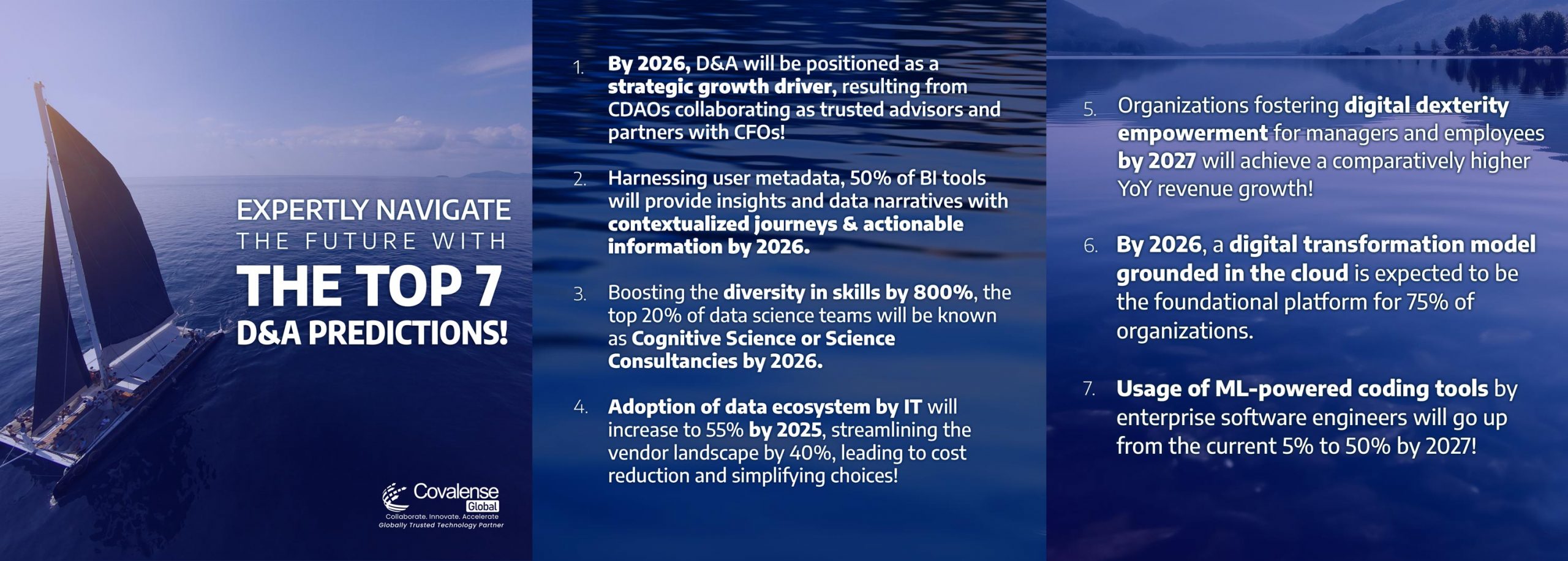
Navigate Data-Driven Horizons with Data & Analytics!

Businesses and organizations are increasingly turning to data and analytics as a cornerstone for strategic decision-making, today. The explosion of digital information, coupled with sophisticated analytical tools, has paved the way for a data-driven revolution across various industries. Data and analytics, once considered a niche domain, have now become indispensable for companies striving to stay competitive in the dynamic landscape of the 21st century. The landscape of Data & Analytics is predicted to witness the above 7 groundbreaking trends. Starting from turning into a strategic growth driver, streamlining vendor landscape to exponential usage of ML-powered coding tools, D&A will reshape the way businesses operate and compete!
In recent years, the explosion of big data has catalyzed a shift towards real-time analytics, enabling organizations to glean insights instantaneously and make agile, data-driven decisions. The integration of machine learning into analytics processes has brought forth predictive capabilities that empower businesses to forecast trends and anticipate market shifts with unprecedented accuracy. Moreover, the democratization of analytics tools has allowed employees at all levels to harness the power of data, fostering a culture of data-driven decision-making throughout organizations.
As we delve into the current landscape of data and analytics, it is crucial to stay on top of the above predictions that are not only shaping the present but also laying the groundwork for the future of data-driven decision-making.
The relevance and significance of data and analytics in today’s world cannot be overstated. It’s not just about collecting vast amounts of data; it’s about extracting meaningful insights and transforming raw information into actionable intelligence. Organizations are leveraging the power of analytics to gain a deeper understanding of their operations, customer behavior, and market trends, ultimately guiding them towards informed decision-making.
- Operational Efficiency:
Data and analytics play a pivotal role in enhancing operational efficiency. By analyzing internal processes, organizations can identify bottlenecks, streamline workflows, and optimize resource utilization. This results in cost savings and improved productivity, allowing businesses to allocate resources more effectively and focus on areas that drive growth.
- Customer-Centric Strategies:
Understanding customer preferences and behavior is crucial in today’s highly competitive market. Data and analytics empower businesses to create a 360-degree view of their customers. By analyzing customer interactions, feedback, and purchase history, organizations can tailor their products and services to meet customer expectations, fostering loyalty and satisfaction.
- Risk Management:
In a world where uncertainties abound, effective risk management is essential for sustainable business growth. Data analytics enables organizations to assess and mitigate risks by identifying patterns and anomalies in data. Whether it’s fraud detection, market volatility, or compliance issues, a data-driven approach equips businesses with the tools to proactively manage and navigate potential challenges.
- Strategic Decision-Making:
The ability to make informed decisions is a hallmark of successful organizations. Data and analytics provide executives and decision-makers with real-time insights, enabling them to make strategic decisions based on concrete evidence rather than intuition. This not only minimizes the risk of errors but also aligns organizational strategies with market dynamics.
- Innovation and Product Development:
The pace of technological evolution demands continuous innovation. Data and analytics serve as a catalyst for innovation by identifying emerging trends, market gaps, and opportunities. Companies can leverage this information to develop new products, enhance existing ones, and stay ahead of the competition in an ever-evolving landscape.
- Supply Chain Optimization:
A well-optimized supply chain is the backbone of any successful business. Data analytics allows organizations to monitor and analyze every aspect of the supply chain, from procurement to distribution. This not only improves efficiency but also helps in predicting demand, reducing lead times, and minimizing excess inventory.
- Employee Performance and Engagement:
Human resources are a critical asset for any organization. Data and analytics assist in evaluating employee performance, identifying training needs, and creating a conducive work environment. By understanding employee sentiments and engagement levels, organizations can implement strategies to boost morale, retain talent, and foster a positive workplace culture.
- Compliance and Governance:
In an age of increasing regulatory scrutiny, compliance and governance are paramount. Data analytics aids organizations in monitoring and ensuring adherence to regulatory requirements. By establishing robust governance frameworks and leveraging analytics for audits, organizations can not only stay compliant but also build trust with stakeholders.
As we navigate the complexities of the digital age, the role of data and analytics in shaping the future of businesses is set only to go upwards. Beyond being a technological buzzword, data analytics has become a fundamental driver of success, offering organizations a competitive edge in an increasingly data-centric world. By harnessing the power of data, businesses can unlock valuable insights, drive innovation, and make informed decisions that lay the foundation for sustained growth and resilience in an ever-evolving landscape. Embracing a data-driven mindset is no longer an option but a strategic imperative for those who aspire to thrive in the dynamic and challenging business environment of the 21st century.
Author: Sales Team
Date: 25 January 2024
